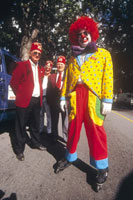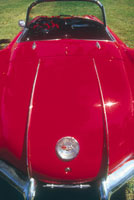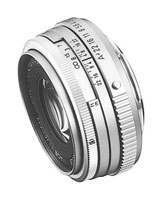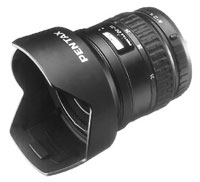Pentax FA 35mm f/2 AL And FA Zoom 20-35mm f/4 AL
After several years of focusing on the compact camera market, Pentax has been working aggressively to expand its 35mm and medium format SLR systems. Two mid-priced wide angle lenses with aspherical optics to assure high imaging performance are an addition to their strategy. Light and compact the FA 20-35mm f/4 AL and the tiny FA 35mm f/4 AL are certainly not lightweights in terms of optical quality. In comparison to the massive FA* 28-70mm f/2.8 AL, it was a pleasure to carry this duo on family outings, while running around documenting several parades, and when hiking for autumn landscape photography. Common Characteristics. Al-though one is a zoom and the other features a fixed focal length, these lenses share a strong family resemblance and design qualities as follows: |
|||
|
|||
Aspherical Optics. Both lenses include one or more "aspherical" elements. These correct spherical aberration (curvature of field) for more consistent edge to edge sharpness at wide apertures, counter comatic flare, and reduce linear distortion. Today, several manufacturers use new methods for creating affordable aspherical elements: such as bonding resin to the glass to form a non-spherical surface layer. The "replica" or "hybrid" (as Pentax calls them) aspherics allow compact AL lenses to compete with the expensive "Pro" AL lenses (with their ground and polished aspherical elements). As Bob Shell has written, such elements produce "anomalous refraction, bending the light to different degrees depending on where the light passes through the lens. This is achieved by varying the curvature which changes across the lens surface from the optical axis out to the edge." With such elements, the designers can reduce the number of lenses required for high edge to edge sharpness even at wide apertures. Thus, overall weight and the propensity for flare (typically worse with more air to glass surfaces) can also be minimized. |
|||
Performance Evaluation. I always carry an ultra-wide zoom, frequently employing the "exaggerated" spatial perspective--an optical illusion causing foreground objects to become more prominent. As well, 20mm is more useful in cramped quarters or when you cannot back up any further to include an entire panoramic scene or a large group of people. None the less, a fast 35mm f/2 lens remains popular, particularly among photographers who will not consider zooms for serious photography. I made the following notes while examining my slides under a 10x loupe: In addition to the above, the fixed focal length lens has two advantages over the zoom. Its maximum aperture is two stops wider, allowing the use of slower (high-resolution) film in handheld photography, and reducing the need for flash or a tripod in low-light situations. It is better corrected for linear distortion, but this factor may not be relevant to many photo hobbyists. However, the FA 35mm f/2 AL does produce images with higher sharpness at the edges of the frame in the f/4 to f/5.6 range; even at f/2 or f/2.8, the optical performance is impressive: suitable for an excellent 8x12 print. Conclusion. The outcome of my tests speaks very highly of the computerized design capabilities of the engineers at the Asahi Optical Co. Ltd., the Pentax parent company. With both AL lenses, I was especially pleased with the consistency of sharpness across the entire image in the mid range of apertures. This is particularly important with a wide angle lens where some subject matter is often included near the extreme edges of the frame. Most photo enthusiasts--particularly those who don't want to lug extra pounds of equipment--will be well served with either of the two lenses tested. Yes, the FA 35mm f/2 provides the highest image quality, but the zoom is a fine performer, too, and is more versatile. Given my own shooting style and choice of subjects, I would want the latter. For my stock photography business, magazine covers, full page newspaper spreads, and wall decor, I would be happy to own either model. Whether for land or cityscapes, informal architectural work, travel photography, or environmental portraits, these AL lenses should satisfy most serious photographers. |
|||
Pentax FA 43mm f/1.9 Limited
Edition This lens is a limited production model, but Pentax will manufacture enough of them to meet demand. And you'll want one too after trying it for even a single roll. Aside from the impeccable construction and mechanical operation, it offers optical performance as befits the price: absolutely superb at all apertures from f/4 to f/16. The wider apertures are primarily useful for problem-solving in low-light situations where flash and tripod are impractical. In extreme close focusing (to 17.8") excellent results are provided at all f/stops, particularly impressive in the f/5.6 to f/11 range. Stop down when possible and you can expect image quality suitable for beautiful 16x24 prints when using professional photographic techniques. Like all Pentax FA lenses, this one can be used on manual focus cameras as well, even those with screwmount, with an adapter. Yes, it is expensive as one would guess from the metal construction, milled focus and f/stop rings, finely engraved numerals, and the metal (well flocked, screw-in type) hood and lens cap that fits over the hood. The 43mm semi-wide focal length is not common today, but this is no common lens. Intended for the discriminating photographer, the FA 43mm f/1.9 offers high prestige value, excellent build quality, and an elegant retro-look that harks back to the earlier days of photography. |
|||
Technical Specifications Lens: FA 35mm f/2 AL |
|||
Lens: Pentax FA 20-35mm
f/4 AL |







































